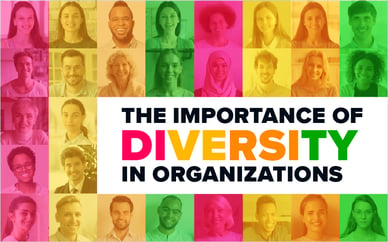Our ability to reach unity in diversity will be the beauty and the test of our civilization. ~ Mahatma Gandhi
Diversity matters. Inclusion matters. They’ve always mattered. But finally…FINALLY diversity and inclusion are in the spotlight, at the forefront and prioritized more than ever before. It’s about. Dang. Time. The modern workplace looks a heck of a lot different than it did 20 or 30 years ago, and in 10 to 20 years, it’s going to be even more reflective of the beautiful tapestry of the human landscape that is striving and struggling to be better, work better and live better. As we continually endeavor to educate a multi-generational, multicultural, multi-dimensional workforce, we must also endeavor to develop eLearning that is reflective of the modern multi-faceted workforce.
The Shifting Landscape
A blog wouldn’t be a blog without some cool stats (and we know you love stats), so here are some fascinating facts about just how much the workforce has shifted - along with a glimpse into the future that is sure to get you revved up about incorporating diversity and inclusion into your eLearning development:
10 Workforce Diversity Facts
- By 2020, the Caucasian population is expected to drop to 63% of the total U.S. population.
- Projected growth from Asian, Hispanic, and multiracial groups will turn traditionally underrepresented populations into majority groups by 2044.
- By 2065, the U.S. will not have any single ethnic or racial majority.
- 57% of employees think their company should be doing more to increase diversity.
- Highly gender-diverse executive teams are 21% more likely to outperform on profitability.
- Racially and ethnically diverse companies are 35% more likely to perform better.
- Diverse teams are 87% better at making decisions.
- Inclusive companies are 1.7x more innovative.
- Companies that have a highly inclusive culture have 2.3x more cash flow per employee.
- Inclusive companies are 120% more likely to hit financial goals.
eLearning Democratizes Training
Technology-based learning has made training more accessible than ever. And in addition to actually covering critical diversity and inclusion topics, eLearning levels the training playing field by providing a means for anyone to access learning from anywhere, at any time.
For example, web accessibility has evolved by leaps and bounds, and those with hearing or visual impairment are now able to leverage assistive technologies to experience online learning like never before.
And today’s globally dispersed learning populations are now able to leverage learning that is rapidly translated and deployed in native languages, via voiceovers and closed captioning.
We Can Still Do Better
While technology-based learning opens a world of opportunities for everyone, we know that to be effective, eLearning needs to be engaging and communicate concepts with clarity, while gaining buy-in so that learners want to – and will – apply what they’ve learned. GREAT NEWS! All of this can be accomplished with inclusive practices.
But what does “inclusive practices” really mean? When developing eLearning, we need to be uber focused on ensuring that the learning is reflective of the modern workforce – or it will fall flat. To accomplish this, we need to keep the following in mind:
- Be aware of bias – What are the demographics of your audience? Your words should leverage bias-free communication. Are you perpetuating stereotypes? Are you being patronizing to particular groups? Are you using ethnic or cultural cliches?
- Vary your visuals – Select graphics and imagery that are reflective of the rich tapestry of your workforce. Ask yourself what the imagery is saying about the company. Are you using all women for office staff? Are you using all white males for leaders? Will all groups feel represented?
- Use authentic audio – Even your vocal and voiceover talent needs to represent diversity. Does it showcase ethnic groups, age groups, gender groups, and dialects? Over-exaggerated and/or fake accents are transparent and condescending. Going the extra mile and sourcing authentic vocal talent will pay off.
- Ask for input – Some of your best resources to help ensure diversity and inclusion are your people. Leverage the unique insights and perspectives of the audience for whom you are developing the training in the first place. Does it appeal to them? Do they feel represented? Do they buy-in and support the concepts? Do they have any concerns?
Be the Change
A 2019 Glassdoor survey found about three in five (61 percent) U.S. employees have witnessed or experienced discrimination based on age, race, gender, or LGBTQ identity in the workplace.
As Stephen Covey once said, “Strength lies in differences, not similarities.” Be the change you want to see and ensure your strongest corporate culture by developing learning supports the solution—instead of perpetuating the problem. eLearning Brothers offers solutions that support diversity and inclusion in your learning development. Reach out today to find out how we can help!








